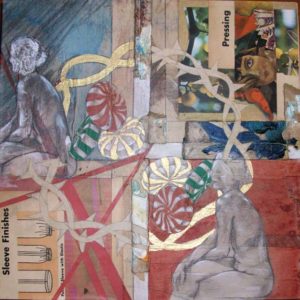
“Sugarmama” by Steed Sigler
Unleashing the Imagination
I paint, therefore, I am. Don’t laugh. We’re not talking philosophy. We’re talking about the benefits of connecting art with well-being.
Art is an innate force that promotes heath for the creator as well as the viewer. To wit: author Elizabeth Gilbert writes the bestselling memoir, Eat, Love, Pray, and is enlightened by the act of writing. Those who love Gilbert’s book say they are enlightened as well.
Upon seeing the original of a sculpted masterpiece for the first time, an art-lover can be stunned into breathlessness—a physical and emotional connection. After playing a concerto to perfection, the classical musician is drained and the audience feels uplifted spiritually—they get chills, for heaven’s sake. Theatre, likewise, has drawn people to its stage lights for the same reason—the exchange of energy between performer and audience. One’s life is better for having done and seen art like this. There’s a release, a catharsis, on both sides.
– Dr. Mike Samuels
In The Critique of Judgment (1790), Immanuel Kant wrote that the arts have transformative powers to change a person’s outlook and the way we experience the world. In contemporary studies, it has been proven that art and music can affect a person’s brain wave patterns, the nervous system and even the cells in the body, and it has the power to promote healing by altering a person’s immune system.
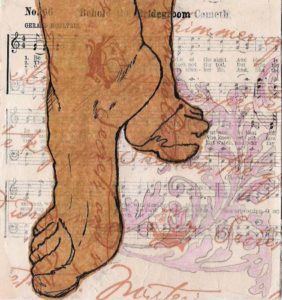
“Dance” by Shannon Steed Sigler, mixed-media and found object collages, part of a yearlong project of 365 different collages
Dance Treatment
After Anna Halprin was diagnosed with cancer, she developed a “psychokinetic visualization” process to approach her treatment holistically.
In the 1970s, the Marin County, California, artist became a pioneer in the expressive arts healing movement. Her cancer went into remission, and she created the Tamalpa Institute, a movement-based approach that integrates dance, visual arts, performance techniques and therapeutic creative practices.
In a chapter of Halprin’s book, Dance as a Healing Art, Dr. Mike Samuels wrote, “Art and healing are lovers, tied together with a silver thread.” When dancing or imagining a dance with healing images, Samuels wrote, the “body actually changes its physiology in response.”
Samuels teaches Art and Healing at San Francisco State University, Institute of Holistic Studies and John F. Kennedy University’s Arts and Consciousness Program. In 1990, he founded Art as a Healing Force, a project devoted to healing with creativity and making art.
“When you see a stick in the road, and you think it’s a snake, you go into fight or flight,” Samuels said. “Your heartbeat speeds up. Your stomach tightens. An image in the brain affects every cell and hormone.” Alternately, when we dance without inhibition, the freedom of movement opens energy channels in our bodies.
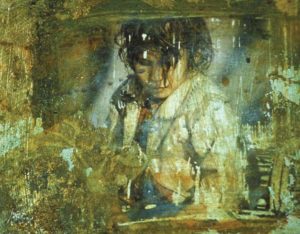
“Threads of Identity” by Gay Bawa Odmark, stitched mixed media on panel
Therapeutic Creation
Whatever chases the demons. Out of chaos comes creation. Ketchum artist Gay Bawa Odmark believes that when “all is lost, there is still a need to create.”
Odmark discovered her creative side growing up in war-torn northern India (now Pakistan), where as a child she witnessed extreme violence. She saw horrors, like severed limbs on the streets, and it was in art classes many years later that she put those images to rest.
“Dark images started coming into my canvas,” she said. “Art was the only way—painting those images that came in front of me. I went back to creativity. I was very sick while I was doing them, and I healed. It was my therapy. There’s an addictive aspect to it.”
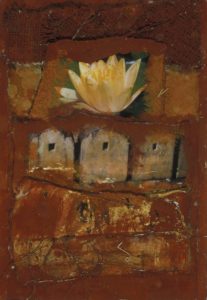
“Girl in Green” by Gay Bawa Odmark, form the Ganges Series, photography and mixed media
Based in Ketchum as a working artist for more than 20 years, Odmark has also volunteered as an art teacher at the Silver Creek Alternative School. She watched students find their artistic voices and, most importantly, be proud of their achievements.
“One after another, when they did art, they changed their brain structure,” she said. “They became more focused.”
As she nurtured others, Odmark’s firsthand knowledge of suffering and resurrection came full circle.
– Gay Bawa Odmark
“Art reveals you to yourself,” she said. “I don’t see myself until I’m painting. It sets a purpose. It’s the glue. Life is creative—it’s a deep need in our journey.”
Odmark has been helped on that journey by working on dream therapy with Jungian therapist Sandy Hyde, of Ketchum.
“I encourage everyone to illustrate their dreams,” Hyde said. “You can gain insights. It’s kind of like a dance between the inner and outer world. It’s an adventure.”
Dreams put you in “touch with your heart,” she continued. “You place yourself in the bigger picture. We look for a more conscious way of living. Why am I here? What is my life about?”
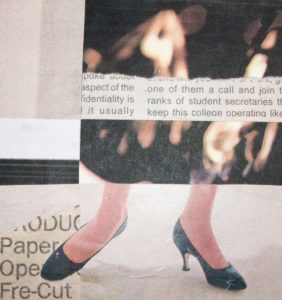
“Glitz,” Shannon Steed Sigler, mixed media and found object collage collection
Drama and the Eternal Spirit
The healing power of art is clear, but how can the benefits be defined? Is this a case of art acting alone, or art triggering a spiritual reaction?
Art therapists work in a broad range of disciplines and methodologies, as do churches and temples and mosques, to achieve the same ends.
The Rev. Ken Brannon of St. Thomas Episcopal Church in Ketchum has worked in both art and spirituality—he received his master’s degree in Drama Therapy from New York University before entering the seminary to become a priest—and has recently merged the two.
“Making art is a unique discipline—there are those who do art because they are compelled,” he said. “Then there are others who focus on health and healing and have found that the arts are an effective way to heal.”
– Rev. Ken Brannon
In his own work with drama therapy, he explained that therapists often begin with a group circle and let stories emerge. Using games, movement and improvisation to brainstorm, the therapist’s role is to winnow out the relevant stories and characters.
“The better the art is, the more effective the therapy is,” he said. “Role-play drama lends itself to connection. Most people think it’s mostly for kids but it’s really, really good for adults.” And it has been used for centuries. Role-playing is a modern heir to the ancient shamanic traditions of healing through ritual drama.
“I do believe that there is eternal spirit that we can tap into that can heal us,” he said. “There is a reservoir of healing. How do I tap into it?”
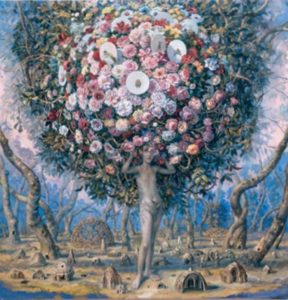
“Self-Portrait with Several Tiny Homes” by Julie Heffernan, oil on canvas, 2009
SPEAK FOR THE TREES
With the release of a new work by Marquand Books, Seattle and Sun Valley gallery owner Andria Friesen has picked up where the furry Lorax left off. Friesen’s compiled project, Speak for the Trees, is a stunning, 200-page hardcover collection of various artists’ attempts to “speak for the trees.” Contributors include contemporary heavyweights like David Hockney, Yoko Ono, Robert Longo and Christo. Each work is accompanied by the artist’s statement and a literary or historical quote borrowed by writers and thinkers ranging from Abraham Lincoln to the Buddha and Henry David Thoreau.
Acknowledging the inherent irony of a book honoring the trees it necessarily consumes, Speak for the Trees has been certified by the Forest Stewardship Council; the paper is made of 100 percent sustainable material, tracked to responsibly managed forests and is printed with soy-based ink.
To get closer to trees, visit Friesen Gallery in Ketchum for the month-long show’s opening on December 30, 2009. Books will be available, art from its pages will be on display and contributing artists will be in attendance. –SVM

